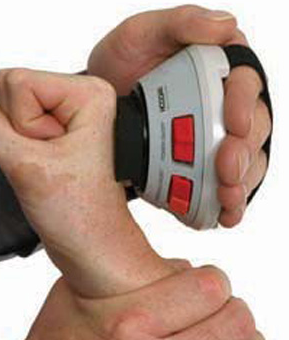 25th Mar 2015
25th Mar 2015
Manual Muscle Testing Principles Explained
Manual muscle testing (MMT) is a very common practice of orthopedic examination specifically designed to assess function and strength of various muscles, usually when rehabilitating sports injuries or recovering from an illness.
Wrist Strength Evaluation with MicroFET 2 Handheld Dynamometer
The basics of performing manual muscle testing procedures usually require the examiner to first isolate a muscle group so that gravity has no impact on the test, then the application of external force and measurement of the results. Results of the test vary depending upon the testing procedures being used. See below for a quick explanation of both testing styles
Definition of Manual Muscle Testing
Manual muscle testing measures effective performance of a movement in relation to the forces of gravity and manual resistance. Physical therapists use their own internal gauge to monitor and evaluate the forces being exerted. Device-less manual muscle testing procedures are becoming less and less popular due to their reliance on subjective muscle strength measurement procedures that vary from examiner to examiner.
Definition of Dynamometery Strength Testing
Dynamometry is a strength testing measurement technique using handheld dynamometers and other sophisticated strength measuring devices to produce accurate, repeatable, strength evaluations. Common devices used in Dynamometry include Grip Strength Dynamometers, Handheld Dynamometers, Push Pull Dynamometers, and many other MMT devices.
The resistance applied at the end of the range being tested is referred to as the 'break test'. In other words, the break test tells the examiner when the muscle being tested is no longer capable of max force and the test is over.
Related Article: The Best Handheld Dynamometers
Comparison of MMT Grades: Daniels and Worthingham vs. Kendall and McCreary
Whichever testing method is used, the resistance should be applied and released gradually to give the patient sufficient time to offer resistance. Following the manual muscle test, the muscle tested is said to be "weak" or "strong" based upon the muscle's ability to resist the externally applied force over time. A number of grading systems exist for manual muscle testing (Table 1).
- When using the Medical Research Council scale, the grades of 0, 1, and 2 require that the examiner eliminate gravity from the equation by positioning the patient accordingly. Gravity-minimized position refers to a positing where contraction is perpendicular to the gravitational force. All other grades are tested in the anti-gravity position.
- The Daniels and Worthingham grading system is considered the most functional of the three grading systems outlined in Table 1 because it tests a motion that utilizes all of the agonists and synergists involved in the motion.
- The Kendall and McCreary approach is designed to test a specific muscle rather than the motion. Kendall and McCreary testing requires both selective engagement of a specific muscle by the patient along with a superior knowledge of anatomy and kinesiology on the part of the clinician, thus opening the door for subjective results.
Choosing a particular grading system is based on experience and skill level of the clinician and very important in determining consistency for each patient. It is imparrative for coworkers who may be re-examining the patient to ensure they using the same testing methods including the effect of gravity, the manual force used by the clinician, the patient's age, the extent of the injury, and cognitive and emotional factors of both patient and clinician.[7-10]
For more information about available Manual Muscle Testing products please shop at ProHealthcareProducts.com
References: Principles of Manual Muscle Testing by mheducation.com







